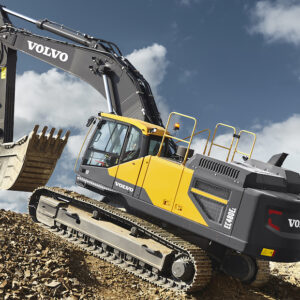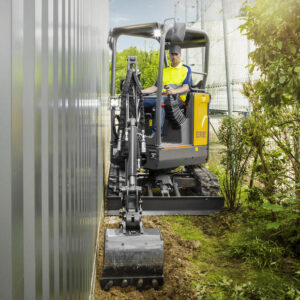I often hear excavators called the “Swiss Army knife” of the construction industry, and it’s true — they’re multi-tasking machines capable on practically any jobsite. A lot of people attribute their flexibility to a broad range of class sizes with multiple attachment options, but you may not realize that a big part of what makes these machines so versatile isn’t what’s on the end of the excavator arm — it’s the boom.
If you’re new to excavators, or if you use product brochures to spec machines, these excavator boom tips may be beneficial the next time you’re in the market for a machine for a specific application.
-

Standard mono excavator boom Mono Boom (Standard Boom): This is what we call the standard setup — it provides good reach and a decent bucket size range and is the most popular setup by far. Some customers use a mass excavation setup, which is a shorter boom and short stick. They go this route because they can put a bigger bucket on it. Using our 42-ton Volvo 380E excavator as an example, you have the choice of a 20′ 4″ (6.2 m) mass excavation boom with an 8′ 4″ stick, which allows you to put on that bigger bucket and move more material. Plus, it’s faster because you don’t have as far to swing. It’s one of the most productive setups, but you can be limited by reach.
-

Two-piece excavator boom Two-Piece Boom: Two-piece excavator booms are very versatile and can actually outlift a mono boom up close to the machine. The mono boom, however, gives you more reach and outlifts a two-piece boom at full extension. Two-piece booms allow you to change the bend of the excavator boom to decrease its working height, which is ideal for digging under a bridge or in a building, for example. The price difference between a mono boom and two-piece boom isn’t very significant, which gives you options to get the configuration you need to best suit the work at hand.
-

Long-reach excavator boom Long-Reach Boom: Long-reach excavator booms are great for cleaning out ponds and canals — jobs where you’re digging out in water and need the extra reach. Boom length varies based on manufacturer and machine model. For example, the long-reach version of the Volvo EC380 excavator is 27′ 11″ (8.5 m) compared to the 21′ 2″ (6.45 m) standard boom and 16′ 5″ (5 m) arm that provide a max reach of 48′ 5″ (14.75 m).
- This brings up a good reminder on machine nomenclature. The “L” in EC380EL means it has a long undercarriage — the “LR” in our EC380ELR stands for long reach.
-

Two-piece offset boom Two-Piece Offset Boom: The two-piece offset excavator boom is another option on some models. A two-piece offset boom knuckles off to the right or the left. If, for example, you’re working in a tight alley with limited swing, you can knuckle the boom over so that it digs in line with one of the tracks up next to a structure. Note on large machines it will decrease your lifting capacity because you have a knuckle and the cylinders out on the boom, so you’re increasing the weight that’s out in front of the machine. Two-piece offset booms are more expensive and can require additional maintenance. This excavator boom configuration is popular in cities with extremely tight workspaces.
In general, a large percentage of customers go with a two-piece boom on wheeled excavators and a standard mono boom on crawler excavators.
A Note on Wheeled Excavators
Wheeled excavators are becoming more and more popular in the U.S. because contractors are learning that they dig just like a crawler excavator but are more versatile. Just pull the outriggers up and drive across the neighborhood or down the street. Or use them for lifters, barriers on the highway, etc. and you won’t tear up the ground. When you’re ready for a different job, just fold up the outriggers, drive to your next jobsite and get to work again.
With outriggers, wheeled machines are just as stable as comparable crawlers — and in some instances, wheeled excavators actually have a wider footprint than a crawler and are more stable. In muddy or rough conditions, crawler excavators are better for the job — but if you’ve never considered a wheeled excavator for your type of work, check them out.
A Unique Value, Only from Volvo
Where Volvo differentiates itself from competitors is in our lifetime frame and structure warranty on all our excavator booms, arms and frames. We’re the only manufacturer that offers this guarantee. When you buy from Volvo, you don’t have to worry about breaking them — they’re guaranteed for life.
View our full excavator lineup to start comparing which machine and boom configuration is right for your job.
And if you’re ready to buy, Volvo dealers across North America have a range of medium and large excavators in stock and ready for your next job. Buy now and take advantage of our special financing with rates as low as 0% for 36 months.
By John Waldron








Thanks for writing this great article for us. I have gained good stuff from this website. Looking forward to your next article. I am happy to share this post to my friends. Keep it up.
I appreciate the great detail in this essay. I had fun reading it, and I’ll put it to good use. I read your blog, and I think it’s great for the great knowledge it contains.